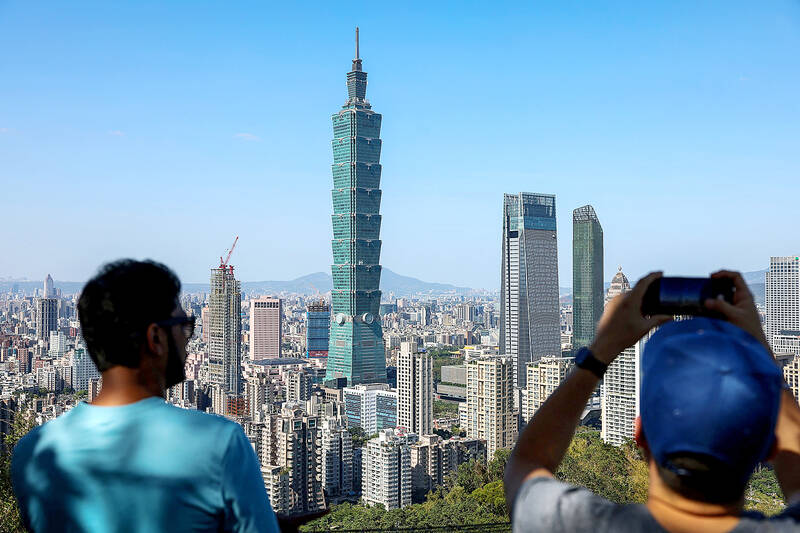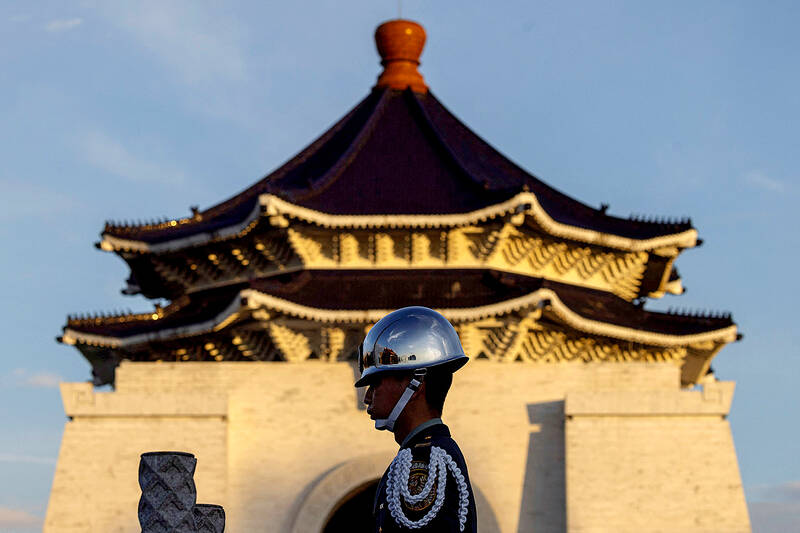The Taipei Times reported last week that housing transactions fell 15.3 percent last month, to under 20,000 units. However, the market boomed for the first eight months of the year, and observers expect it to show growth for the year as a whole.
The fall was due to Central Bank intervention.
“The negative impact of credit controls grew evident for the third straight month,” said Sinyi Realty Inc (信義房屋) research manager Tseng Ching-ter (曾敬德), according to the report.

Photo: AFP
Central Bank Governor Yang Chin-long (楊金龍) in October said that the Central Bank implemented selective credit controls in September to cool the housing market. The controls were put in place because the bank feared that a speculative bubble was forming in the housing market, with prices rising quickly, driven by consumer expectations that prices would continue to rise.
Consumers seem unaware, or at least unaffected, by the fact that the population is shrinking. They expect that prices of property will always rise and they prefer to own rather than rent. Nor are homeowners generally willing to rent out vacant houses, since the income is often perceived as not worth the trouble, and taxes are low. Hence, the singular market characteristics of Taiwan, with its high housing prices, high vacancy rate and high ownership rate, which is over 80 percent in the big cities.
The result is a market in which the number of first-time home buyers is low, and most buyers already own a home. In August last year the government launched a subsidy program to increase the number of first-time home buyers by helping them with mortgages.

Photo: Reuters
LANDOWNERS COMPLAIN
Why is it so difficult to obtain houses at low prices even though Taiwan is overbuilt? Some of the issues I have explored before. But another factor in the housing price explosion is land planning decisions made early in the democratic era that have handed Taiwan’s urban “planning” over to developers.
A Rutgers-based scholar, Mi Shih (史宓), has written a series of papers on planning and the conversion of the domestic economy to a real-estate based economy. According to Shih, the story begins in the 1970s with the issue of land zoned as reserved land (保留地) — that is, land for public facilities such as roads and parks, which could not be developed. However, the law required that private landowners whose land becomes reserved land be compensated, but in the Martial Law era, there was no legal requirement to pay in the short term. Hence, local governments routinely delayed or refused to pay. Shih instances a 1988 estimate showing that “Taiwan had nearly 41,000 hectares of reserved land in total, with a compensatory cost almost double that of all Taiwanese governmental budgets combined.”
This blew up into a crisis because the law required that all reserved land compensation be paid out by September of 1988 or else the land would be de-zoned. The legislature amended the Urban Planning Act (都市計畫法) to remove that requirement, and landowners began to yell, “generating a roaring grassroots discontent to which the rapidly democratizing Taiwanese government could not turn a deaf ear,” Shih says.
That was also the time when the Snails Without Shells protests over suddenly rising housing prices were taking place.
TRANSFERABLE DEVELOPMENT RIGHTS
As in so many policymaking situations, planners looked to the US for solutions, borrowing the idea of transferable development rights (TDR). In American practice, the government often gives TDRs to landowners and developers to facilitate planned development that extends beyond the property they own. Major cities that use this approach carefully monitor and manage it to keep cities compact and reduce community objections.
Shih says that Taiwanese planners intended to use TDRs to get developers to finance government compensation for reserved land. However, the Taiwanese TDR model, known as “floating TDR,” does not require government-designated receiving sites and gives developers great legal freedom to build TDR projects almost anywhere. Developers simply “move” the permitted floor space from the public reserved lands to their projects, often exceeding local density limits. Shih adds that “3,764 development projects have utilized TDR since the early 2000s, generating 807 hectares of floor area in excess of existing density limits — roughly equivalent to adding 100,875 new, market-rate apartments.”
This freedom from regulatory restriction means that local governments do not capture most of the land value created by building construction. It goes to developers, a massive hidden subsidy to land development. Community input in this process is entirely lacking, an example of the way early democratic era regulators retained the mindset of the authoritarian era.
In a later paper Shih and Chang Ying-hui (江穎慧) at National Chengchi University show how the TDR approach, coupled with formulaic density calculations, produce urban landscapes in Taiwan, land speculation and commodification, and the current real-estate driven economy. When they calculate the value of land, developers know what density numbers will be permitted by the government. These they treat as extra profit. Together, TDR practices and density valuations drive increased land brokerage and land transactions, pushing up prices. This creates, they contend, a “financially more calculable urban world in which capital’s acquisitive appetite for land’s monetary value is intensified.” Moreover, Shih and Chang argue, because these approaches are viewed by planners, developers and the public at large as purely technical decisions, they escape political scrutiny.
Worse, in yet another paper on Taiwan TDR practices, Shih and colleagues observe that TDR projects push up the value of nearby residential properties as well, making homes for lower income groups even less affordable.
It should now be obvious why the Central Bank is tinkering with the interest rates to cool down the housing market: interest rate changes have no effect on the political economy of residential development, and on the legal arrangements that favor developers over all other players in the market.
The Central Bank’s intervention exists solely to keep the market from exploding and then collapsing, a way of keeping a permanent crisis from spinning out of control — like so many other government interventions in Taiwan’s numerous permanent crises.
Notes from Central Taiwan is a column written by long-term resident Michael Turton, who provides incisive commentary informed by three decades of living in and writing about his adoptive country. The views expressed here are his own.

Most heroes are remembered for the battles they fought. Taiwan’s Black Bat Squadron is remembered for flying into Chinese airspace 838 times between 1953 and 1967, and for the 148 men whose sacrifice bought the intelligence that kept Taiwan secure. Two-thirds of the squadron died carrying out missions most people wouldn’t learn about for another 40 years. The squadron lost 15 aircraft and 148 crew members over those 14 years, making it the deadliest unit in Taiwan’s military history by casualty rate. They flew at night, often at low altitudes, straight into some of the most heavily defended airspace in Asia.

Beijing’s ironic, abusive tantrums aimed at Japan since Japanese Prime Minister Sanae Takaichi publicly stated that a Taiwan contingency would be an existential crisis for Japan, have revealed for all the world to see that the People’s Republic of China (PRC) lusts after Okinawa. We all owe Takaichi a debt of thanks for getting the PRC to make that public. The PRC and its netizens, taking their cue from the Chinese Communist Party (CCP), are presenting Okinawa by mirroring the claims about Taiwan. Official PRC propaganda organs began to wax lyrical about Okinawa’s “unsettled status” beginning last month. A Global

Taiwan’s democracy is at risk. Be very alarmed. This is not a drill. The current constitutional crisis progressed slowly, then suddenly. Political tensions, partisan hostility and emotions are all running high right when cool heads and calm negotiation are most needed. Oxford defines brinkmanship as: “The art or practice of pursuing a dangerous policy to the limits of safety before stopping, especially in politics.” It says the term comes from a quote from a 1956 Cold War interview with then-American Secretary of State John Foster Dulles, when he said: ‘The ability to get to the verge without getting into the war is

Like much in the world today, theater has experienced major disruptions over the six years since COVID-19. The pandemic, the war in Ukraine and social media have created a new normal of geopolitical and information uncertainty, and the performing arts are not immune to these effects. “Ten years ago people wanted to come to the theater to engage with important issues, but now the Internet allows them to engage with those issues powerfully and immediately,” said Faith Tan, programming director of the Esplanade in Singapore, speaking last week in Japan. “One reaction to unpredictability has been a renewed emphasis on